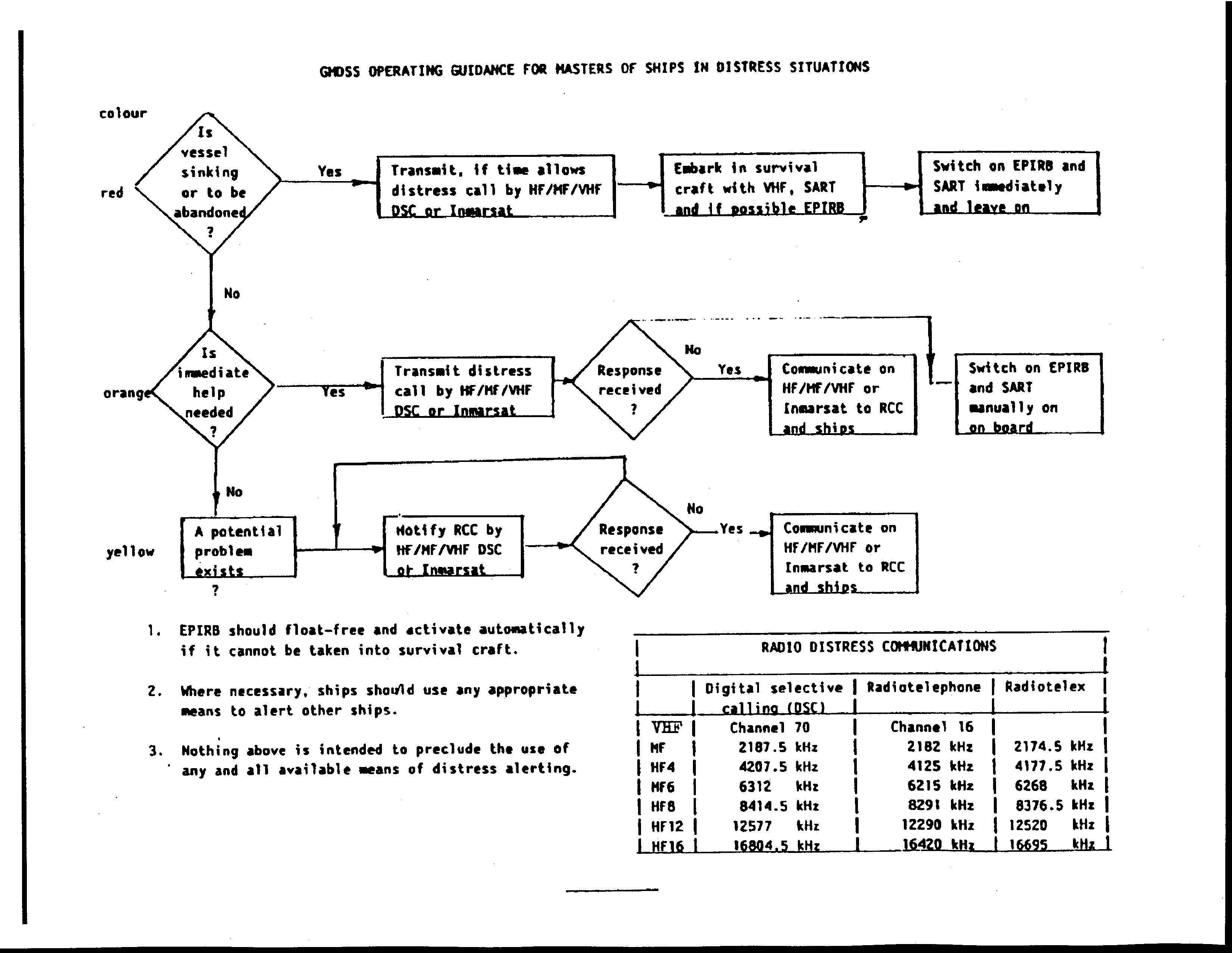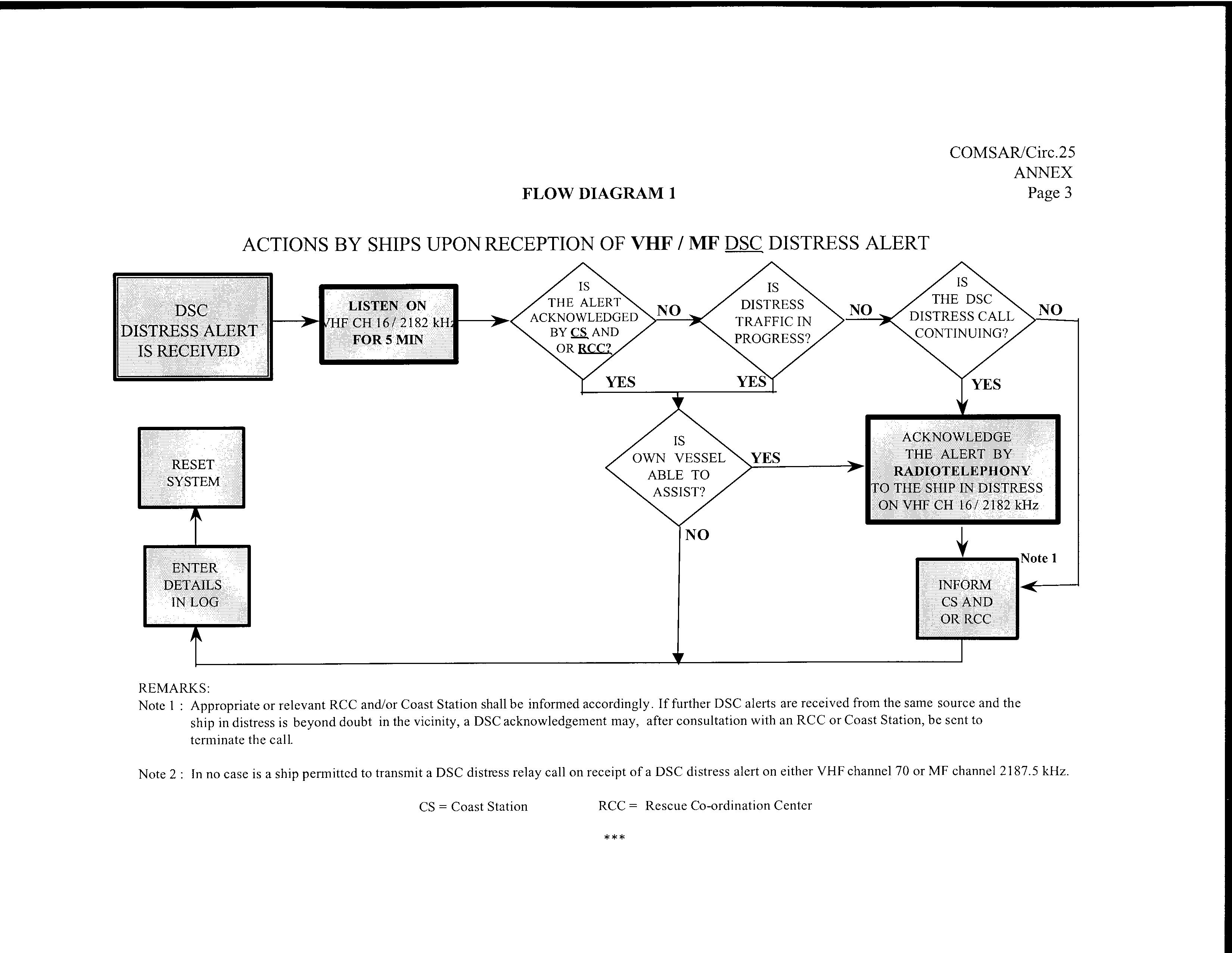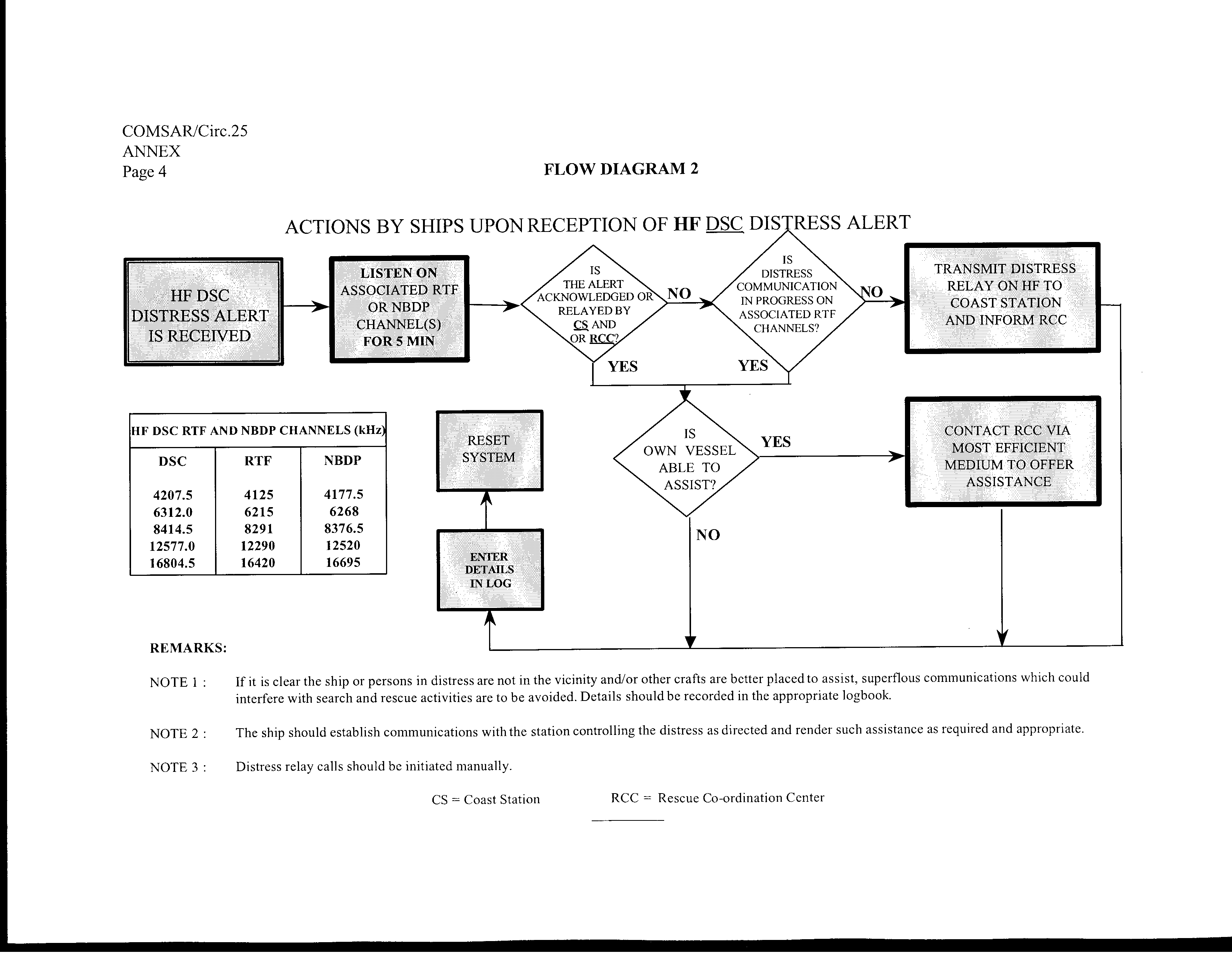Ship Safety Bulletins (SSB)
Date (Y-M-D): 2001-08-08
Subject: Global Maritime Distress and Safety System ( GMDSS ) and Guidance on Important Operational Procedures
This Bulletin brings to the attention of masters and personnel responsible for maintaining a radio watch important information on the use of GMDSS radio equipment. Many Canadian domestic commercial ships will now be using GMDSS equipment, and in the next couple of years the number of smaller ships carrying GMDSS equipment will greatly increase.
Masters and radio operators are urged to review and use the information contained in this bulletin to help ensure the GMDSS and Search and Rescue ( SAR ) services can operate as efficiently and effectively as possible.
New Regulations
Following several years of development and consultation, the new Ship Station (Radio) Regulations, 1999 and the new Ship Station (Radio) Technical Regulations, 1999 came into force on April 1, 2001. Affected immediately by these Regulations are Canadian domestic ships operating on the seacoasts of Canada, which are not in a Vessel Traffic Services Zone, and that:
- are 20 meters in length or more and certified to carry more than 12 passengers; or
- have a gross tonnage of 300 tons or more
These ships will be carrying and using new radio equipment consistent with the GMDSS . The new regulations also phase-in requirements over the next couple of years that will apply to smaller commercial ships (including small fishing vessels and small passenger vessels) operating on the seacoasts of Canada (Note in particular that by April 1, 2002, vessels 8 metres or more in length and operating more than 20 miles from shore will need an EPIRB . By February 1, 2003, tow boats, vessels carrying more than 6 passengers and vessels of closed construction more than 8 metres in length will need a VHF DSC radio). In addition, amendments have been made to other regulations to update the requirements pertaining to survival craft radio equipment e.g., Life Saving Equipment Regulations, Small Fishing Vessel Inspection Regulations and the Large Fishing Vessel Inspection Regulations. Although the regulations should be consulted for specific requirements, a table of the carriage requirements is attached for reference (Annex 1). The complete regulations can be reviewed at the following website: http://www.tc.gc.ca/Actsregs/csa-Immc/Toccsa.html.
Guidance for Masters in Distress Situations and Alerting of Sar Authorities
In 1992, the International Maritime Organization ( IMO ) prepared a flow chart providing GMDSS operating guidance for masters of ships in distress situations (COM/Circ.108). It was recommended that this chart be displayed on the ship's bridge.
Later, another circular (MSC/Circ.892) was prepared to strongly emphasize the importance for ships to alert SAR authorities at the earliest possible moment in any situation that may involve a danger to life or that has the potential of developing into such a situation.
For mariners information and guidance, the following has been attached:
- Annex 2 - GMDSS Operating Guidance for Masters of Ships in Distress Situations (COM/Circ.108, Annex)
- Annex 3 - Alerting the Search and Rescue Authorities (MSC/Circ.892, Annex)
False Distress Alerts and Distress Relay Alerts
The GMDSS has been in force for ships on international voyages since February 1, 1999, following its seven year phase-in. During this time, considerable experience was gained internationally in the operation of the GMDSS . While the GMDSS has proven its overall effectiveness, the high number of accidental distress alert activations and the inappropriate and unintended Digital Selective Calling ( DSC ) distress relay alerts have detracted from the efficiency of the system. Excessive false alerts and distress relay alerts can create an unnecessary burden and workload for SAR services. They may also cause confusion and undermine mariner's confidence in the GMDSS . They could potentially have a serious impact on real distress situations.
With the aim of minimizing the number of false alerts and distress alert relays, this Bulletin contains the following additional attachments:
- Annex 4 - "Instructions for Mariners and Others' on How to Cancel a False Alert" (Appendix to IMO Resolution A.814(19) entitled Guidelines for the Avoidance of False Distress Alerts)
- Annex 5 - "Procedures for Responding to DSC Distress Alerts by Ships" (COMSAR/Circ.25) with two Annexes
Annex 1
Ship Station (Radio) Regulations, 1999
Grey cells : Ships ≥ 20m and certified to carry >12 passengers, or ships ≥ 300gt
White cells : All other ships
Italics represent new requirements to be complied with by April 1st, 2001, unless otherwise indicated.
- Requirements for Safety Convention ships are not shown as they must comply with the Safety Convention
- Requirement for ships on inland voyages and minor waters voyages are not shown since there are no new requirements
- Regulations do not apply to a pleasure yacht not carrying a master or crew for hire, or a tow-boat in a booming ground
|
Equipment |
Sea Area A1 or VHF Area |
Sea Area A3 |
Sea Area A4 |
|
|---|---|---|---|---|
|
VHF Radio with DSC |
Yes -unless ship operates within a VTS Zone, then will have until January 31, 2003, or until the sea area A1 is completed, whichever is latest |
|||
|
(SSRR) |
Yes - by February 1, 2003, or after sea area A1 completed, whichever is latest
-exempted are ships on a home-trade voyage, class IV in a VTS Zone -current VHF radiotelephone provisions remain in effect until then |
|||
|
Inmarsat Ship Earth Station with EGC , and MF Radio with DSC , Or |
no |
Yes ( EGC required only if outside NAVTEX range) |
Yes MF / HF option only |
|
|
MF / HF Radio with DSC and NBDP (SSRR) |
no |
|||
|
no |
Yes |
no |
||
|
NAVTEX Receiver (no change to current requirement-SSRR) |
no |
Yes
|
no |
|
|
Yes |
||||
|
EPIRB (float-free) (SSRR) |
Yes
(Note: EPIRB does not have to be float-free if less than 15gt) -exempted are ships on home-trade voyages, class IV or minor waters voyages |
|||
|
Radar Transponder(s) ( SART s) (SSRR, Life Saving Equipment Regulations, Large Fishing Vessel Inspection Regulations, and Small Fishing |
no |
Yes 2 are required, unless ship is certified to carry ≤12 passengers and is <500gt, then carry 1 |
||
|
Vessel Inspection Regulations) |
Yes 1 if 20m in length or over on > HTII voyages; but, can continue to carry 2 Class II EPIRBs instead until one of the batteries expire. |
|||
|
Survival Craft VHF Portable Radio (Life Saving Equipment Regulations, Large Fishing Vessel Inspection Regulations) |
Yes 3 are required, unless ship is certified to carry ≤ 12 passengers and is <500gt, then carry 2 (new requirement for ships on home-trade voyages, class III) |
|||
|
no |
Yes 3 are required if ship is certified to carry >12 passengers |
|||
|
Yes |
||||
|
Reserve Source of Energy |
Yes if ship is ≥20m, is carrying more than 6 passengers, or is a tow-boat |
|||
DSC : digital selective calling EGC : enhanced group calling NBDP : narrow band direct printing
Additional requirements: emergency procedures card, operating and routine maintenance manuals, consumable spare parts, radio publications, time piece, weather facsimile (Arctic), spare antennas (some ships ≥20m).
Annex 2
Annex 3
ALERTING THE SEARCH AND RESCUE AUTHORITIES
Msc/Circ.892
1. The need for the earliest possible alerting of the search and rescue ( SAR ) co-ordination authority to maritime emergencies cannot be over-emphasised.
2. It is essential to enable shore-based facilities to respond without delay to any situation which constitutes, or has the potential to constitute, a danger to life. Time lost in the initial stages of an incident may be crucial to its eventual outcome. It cannot be regained.
3. Factors to be considered include position (in relation to hazards and to shore-based or other SAR units); time of day; weather conditions (actual & forecast); the number of persons at risk or potentially at risk; specific assistance required, etc.
4. It is always best to consider the 'worst-case scenario' and to alert the SAR organisation accordingly. Depending on the circumstances, the co-ordinating authority may choose to alert or despatch SAR facilities as a precautionary measure and/or to reduce transit times. If assistance is not subsequently required, any such positive response can be easily curtailed. But time lost through delays in notification can never be regained.
5. It is therefore essential that the SAR co-ordinating authority be informed immediately of:
Operating guidance for masters of ships in distress or urgency situations*
6. The following diagram shows standard procedures for distress/urgency message routeing. It is for guidance only, and does not preclude the use of any and all available means of distress alerting.
* To be considered in conjunction with IMO publication 969 - GMDSS Operating Guidance for Masters of Ships in Distress Situations (COM/Circ.108 of 23 January 1992.
Operation guidance for masters of ships observing another vessel apparently in danger
7. The following diagram shows suggested procedures for reporting concerns about the safety of another vessel (fire, smoke, adrift, navigating towards a danger, etc.).
Annex 4
Appendix
Instructions for Mariners and Others* on How to Cancel a False Distress Alert
DSC
1 VHF
Example
All Stations, All Stations, All Stations
This is NAME, CALL SIGN,
DSC NUMBER, POSITION.
Cancel my distress alert of
DATE, TIME UTC,
= Master NAME, CALL SIGN,
DSC NUMBER, DATE, TIME UTC
2 MF
* Appropriate signals should precede these messages in accordance with the ITU Radio Regulations Chapter NIX.
** This applies when the false alert is detected during transmission.
Example
All Stations, All Stations, All Stations
This is NAME, CALL SIGN,
DSC NUMBER, POSITION.
Cancel my distress alert of
DATE, TIME UTC,
= Master NAME, CALL SIGN,
DSC NUMBER, DATE, TIME UTC
3 HF
As for MF , but the alert must be cancelled on all the frequency bands on which it was transmitted. Hence, in stage 2.2 the transmitter should be tuned consecutively to the radiotelephony distress frequencies in the 4, 6, 8, 12 and 16 MHz bands, as necessary.
4 Inmarsat-C
Notify the appropriate RCC to cancel the alert by sending a distress priority message via the same CES through which the false distress alert was sent.
NAME, CALL SIGN, IDENTITY NUMBER,
POSITION,
Cancel my Inmarsat-C distress
alert of DATE, TIME UTC
= Master +
5 EPIRBs
If for any reason an EPIRB is activated accidentally, the ship should contact the nearest coast station or an appropriate coast earth station or RCC and cancel the distress alert.
6 General
6.1 Notwithstanding the above, ships may use any means available to them to inform the appropriate authorities that a false distress alert has been transmitted and should be cancelled.
6.2 No action will normally be taken against any ship or mariner for reporting and cancelling a false distress alert. However, in view of the serious consequences of false alerts, and the strict ban on their transmission, Governments may prosecute in cases of repeated violations.
Annex 5
PROCEDURE FOR RESPONDING TO DSC DISTRESS ALERTS BY SHIPS
COMSAR/Circ.25
1 Introduction
The Sub-Committee on Radiocommunications and Search and Rescue ( COMSAR ), at its fourth session (12 to 16 July 1999), decided that digital selective calling ( DSC ) relays of distress alerts on all shipborne DSC equipment should be reduced and prepared a procedure for responding to VHF / MF and HF distress alerts, given in flow diagrams 1 and 2, recommending that it be displayed on the ship's bridge as A4 size posters. It also prepared the following guidance.
2 Distress relays
2.1 Radio personnel serving on ships should be made aware of the consequences of transmitting a distress relay call and of routeing a DSC distress relay alert to other than coast stations ( CS ).
2.2 The number of unintended activations of DSC distress alerts and DSC distress relay alerts creates extra work load and confusion to (M)RCCs and also causing delay in the response-time. The original distress alert from a ship in distress should not be disrupted by other ships, by transmitting a DSC distress relay alert.
2.3 Recommendation ITU -R M.541-8 on Operational procedures for the use of DSC equipment in the Maritime Mobile Service identifies only two situations in which a ship would transmit a distress relay call (distress relay alert):
2.4 In no case is a ship permitted to transmit a DSC distress relay call on receipt of a DSC distress alert on either VHF or MF channels.
2.5 Distress relay calls on HF channels should be initiated manually.
2.6 Compliance with operational and technical provisions above would prevent transmissions of inappropriate distress relay calls.
3 All coast stations call
3.1 Recommendation ITU -R M.493-9 on DSC systems for use in the Maritime Mobile Service provides for "group calls" an address consisting of the characters corresponding to the station's Maritime Mobile Service identity ( MMSI ) and a number of administrations have already assigned a "group call" MMSI to their coast stations in addition to the coast station's individual MMSI .
3.2 By multilateral agreements, a "group call" MMSI could be assigned to all coast stations of a specific region, e.g., an RCC area and could comply with IMO's requirement without need of introducing further modifications to GMDSS equipment.
3.3 An alternative method to implement an "all coast stations" call without the need to modify Recommendation ITU -R M.493-9 could be to define one MMSI world-wide as an address for all coast stations, in accordance with Nos. S19.100 to S19.126 of the ITU Radio Regulations. However, this solution would also require a modification of the setup at each coast station participating in the GMDSS .
4 Authorization
It should be noted that on ships, distress alerts, distress acknowledgements and distress relay calls can only be transmitted with permission of the Master of the ship.
5 Flow diagrams
5.1 The simplified flow diagrams* 1 and 2 describe actions to be taken aboard ships upon receipt of distress alerts from other ships. Administrations should give wide distribution of these flow diagrams to ships and training institutions.
5.2 Member Governments are invited to bring the above guidance and the attached flow diagrams to the attention of their shipowners, seafarers, coast stations, RCC s and all others concerned.
* Elements of flow diagrams are shadowed in different shades meaning different colours if printed on a colour printer.
The following document is available for downloading or viewing:
To access the Portable Document Format ( PDF ) version you must have a PDF reader installed. If you do not already have such a reader, there are numerous PDF readers available for free download or for purchase on the Internet:
Keywords: Questions concerning this bulletin should be addressed to:
2. Ship Station
3. Radio
Robert Turner
613-991-3134
Marine Safety
Tower C, Place de Ville
11th Floor, 330 Sparks Street
Ottawa, Ontario K1A 0N8
To add or change your address, contact us at: marinesafety@tc.gc.ca
Owners of commercial vessels, registered and licensed, automatically receive Bulletins.




